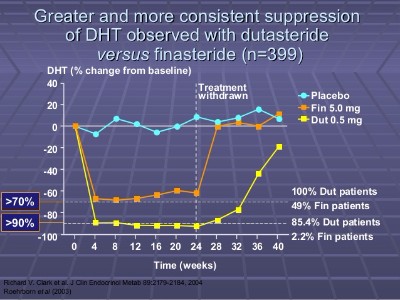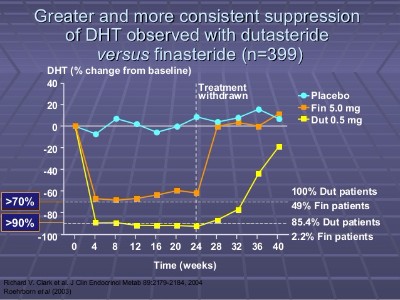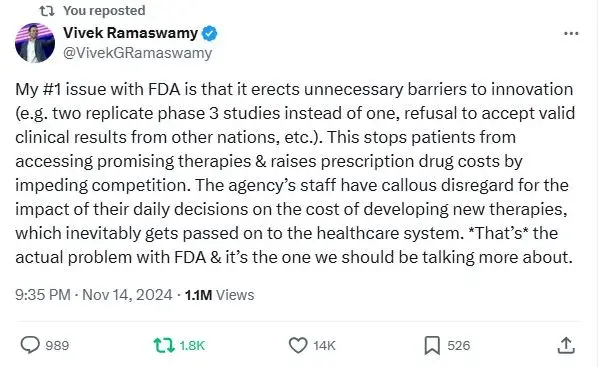Finasteride (5 mg) was originally approved by the US FDA in 1992 to treat enlarged prostates (BPH) in older men under the brand name Proscar. In 1997, the manufacturer Merck got FDA approval to treat hair loss with finasteride (1 mg) under the brand name Propecia. It is one of only two drugs that have ever been approved to treat hair loss in the US or Europe, with the other being minoxidil (brand name Rogaine).
Finasteride blocks the 5?-reductase enzyme (type II and III isoforms), drastically limiting the conversion of testosterone to dihydrotestosterone (DHT). DHT is the main hormone responsible for increased body hair and reduced scalp hair.
Note that dutasteride (a stronger 5?-reductase inhibitor than finasteride, including type I and II isoforms) is approved to treat hair loss in Japan and South Korea. In the US, many people use dutasteride off-label to treat their male pattern hair loss (aka androgenetic alopecia). See my posts on finasteride and dutasteride dosage comparisons and finasteride and dutasteride combination treatment.

Finasteride Prescriptions in the US Rise 200 Percent in 7 years
A new report from Epic Research (conducted on behalf of NBC News) has made a startling finding. The number of men in the US with finasteride prescriptions increased nearly 200% in the last seven years.
Note that the above data does not even include topical finasteride, which is now sold by a large number of companies via online consultations. And many people get the oral drug imported from various foreign nations via sketchy websites without a prescription. Some are even getting finasteride injections into their scalps.
According to the ClinCalc DrugStats Database, finasteride was the 88th most prescribed drug in the US in 2021. Based on these latest findings from Epic Research, this ranking must have gone up significantly in 2023.
While the Epic report looked at all men 25 and older, the increase in prescriptions is likely driven mostly by young and middle-aged hair loss patients. The older enlarged prostate patient segment is already well established and not targeted by all the new ads promoting finasteride for hair growth. Moreover, there are other popular medications for enlarged prostates (e.g., Flomax); and a host of new minimally invasive surgical procedures to permanently reduce prostate size.
Doctors also say that they are seeing more and more young men seeking treatment for hair loss at an earlier age, including some in their late teens. Social media, YouTube videos and Reddit before and after finasteride hair growth photos are all contributing factors.
Moreover, there has been a proliferation or telemedicine companies such as Hims, Keeps and Ro. And these well funded companies all promote finasteride very heavily via online ads, billboards, social media and sponsorship of sporting events.
The earlier you start treating hair loss, the better the results. Of course this assumes that you get no sexual or other side effects from using finasteride. Per most findings, any such side effects are almost never permanent. However, you could be one of unlucky few, so it is always best to shave your head first and see if you can handle the appearance. That way, you never need to get on any lifelong drug treatment plan in the first place. Finasteride also impacts testosterone and estrogen levels, though usually not by much.
Note that finasteride can work for a very very long time in treating your hair loss, at least in Japanese men. As an added bonus, recent findings suggest that the drug could also lower the risk of heart disease via reducing cholesterol levels.

